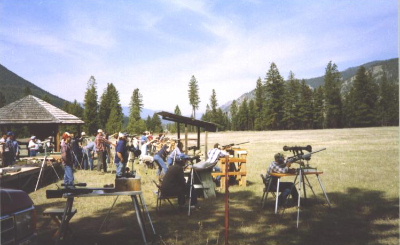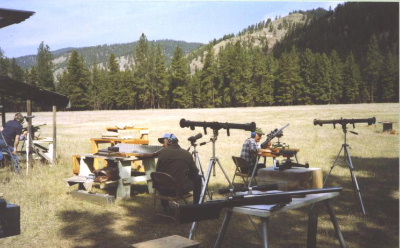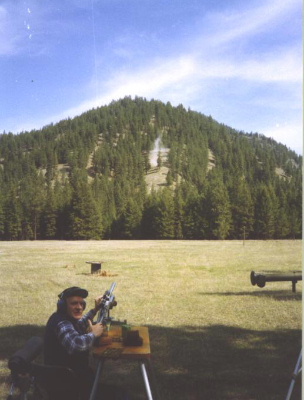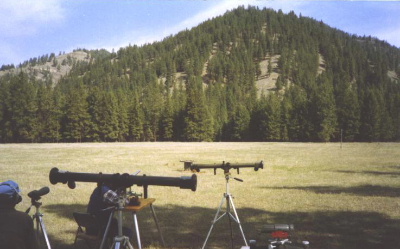Shooting Dynamite out to 1200 Yards
January 23, 2015 2:42 am(The following article was published in the August 1988 issue of Precision Shooting Magazine. The dynamite shoots are no longer held in Superior, MT. In February of 2004 I was contacted by an Idaho group that is now holding a dynamite shoot. Here is a link to their shoot: http://www.boomershoot.org )
About fifty miles west of Missoula, Montana on Interstate 90, in the scenic Clark Fork River valley, is the town of Superior. From a shooter’s point of view, what makes Superior different from other small towns scattered along this western Montana river valley is its dynamite shoots.
Several times each spring and fall; the Mineral County Sportsmen’s Club holds a dynamite turkey shoot. The target is a one-quart oil can painted fluorescent orange, with a stick and a half of dynamite placed inside. Sixty of these cans are carefully placed on the side of a mountain, at a distance of 400 to 1200 yards from the benches.

The rules are simple. When it’s your turn to shoot, you and your rifle sit at one of five benches and you get three shots at hitting one of the dynamite cans. The cost is one dollar per shot.
If you hit a can, you get one of the bigger thrills in shooting you’ll ever get. First, for just an instant you will see an orange burst of fire. Then a huge dust cloud covers up everything, and then you will hear a resounding boom, as the target is far enough away that the noise takes a moment to reach the firing line. If the excitement of hitting the dynamite isn’t enough, you can also collect a frozen turkey from the clubhouse.
What type of accuracy and equipment does it take to hit a target the size of an oil can out to 1000-plus yards? Well, an oil can measures 4” X 5.5”. If we take the smaller of the two dimensions, 4”, one minute of angle at 400 yards is 4”. An oil can at 600 yards is 2/3 rds minute of angle. At 800 yards, it is ½ minute of angle. At 1000 yards it is 4/10 minute of angle. Obviously at the longer ranges everything must be just right with range estimation, scope settings, and rifle hold, let alone the accuracy potential of the rifle. A little luck and a good spotter go a long way in hitting one of the far targets.
What type of rifles do the shooters use? Well, at the first match of the 1988 season, held April 15th, most of the 50-60 competitors used the same rifle they use during the elk and deer season. Magnum 7mm’s probably are the most common cartridge, but not by a big margin. There were 6mm Remington’s, 25-06’s, 264 Win Mags, quite a few magnum thirties, and even a 340 Weatherby. Quite a few of the rifles have been rebarreled with heavier and longer barrels.

Probably one of the keys in consistently hitting the target at the longer ranges is using a quality, match-type bullet. Shooting a quality bullet of high ballistic coefficient at high velocity is the name of the long-range shooter’s game. The 7mm and 30 calibers have the best bullet selection, like the Sierras. The Nosler Ballistic Tip is also a good choice.
The bullets must be either a soft point or a hollow point, as the fellows who place the charges report that a full-metal-jacket bullet will usually not set off the dynamite. They just punch a hole on through.
Probably the most common scope is the Leupold, often with click adjustments and quite a bit of power – either a fixed power up to 30x, or a variable cranked up.

As I mentioned earlier, many of the rifles are hunting rifles, but there are also some full-blown, long-range benchrest-type rifles, weighing up to 35 pounds or so and barreled with a high-quality benchrest barrels chambered for a 300 Weatherby, 7 mag, or maybe a necked-down 378 Weatherby case. With these rifles, most of the closer shots are easy, and the shooters concentrate on the farther cans. (There is one about 850 yards out that hangs from a tree by a piece of rope, if you’re looking for a challenge.)

Although not common, some shooters bring sophisticated range-finding equipment that is capable of accurately measuring the distance to the target to within a few yards. Almost everyone uses either a spotting scope or a pair of binoculars for spotting. Without a good spotter, hitting can be difficult.
Combined with the use of a rangefinder, a computer printout of your bullets trajectory and the minutes of scope adjustment needed for a given range make hitting the target with a minimum of “sighter” shots easier. When the light is right, the spotter, when looking through a spotting scope placed behind the shooter, can actually see the bullet as it arcs its way to the target.


